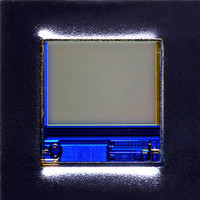MT9V011P11STC:B Aptina LLC, MT9V011P11STC:B Datasheet - Page 11

MT9V011P11STC:B
Manufacturer Part Number
MT9V011P11STC:B
Description
SENSOR IMAGE VGA COLOR CMOS PLCC
Manufacturer
Aptina LLC
Series
DigitalClarity®, Micron®r
Type
CMOS Imagingr
Datasheets
1.MT9V011P11STCB.pdf
(33 pages)
2.MT9V011P11STCB.pdf
(2 pages)
3.MT9V011P11STCB.pdf
(2 pages)
Specifications of MT9V011P11STC:B
Pixel Size
5.6µm x 5.6µm
Active Pixel Array
640H x 480V
Frames Per Second
30
Voltage - Supply
2.8V
Package / Case
28-PLCC
Lead Free Status / RoHS Status
Lead free / RoHS Compliant
Other names
557-1315
Available stocks
Company
Part Number
Manufacturer
Quantity
Price
Company:
Part Number:
MT9V011P11STC:B
Manufacturer:
RENESAS
Quantity:
1 001
Part Number:
MT9V011P11STC:B
Manufacturer:
MICRON
Quantity:
20 000
Serial Bus Description
Protocol
Sequence
Bus Idle State
Start Bit
PDF: 817d5189/Source: 817d5173
MT9V011_C82S_2_PLCC.fm - Rev. B 1/05 EN
Registers are written to and read from the MT9V011 through the two-wire serial inter-
face bus. The sensor is a serial interface slave and is controlled by the serial clock (SCLK),
which is driven by the serial interface master. Data is transferred into and out through
the MT9V011 serial data (S
1.5KΩ resistor. Either the slave or master device can pull the SDATA line down—the
serial interface protocol determines which device is allowed to pull the S
at any given time. The registers are 16 bits wide, and can be accessed through 16- or 8-
bit two-wire serial bus sequences.
The two-wire serial interface defines several different transmission codes, as follows:
• a start bit
• the slave device 8-bit address
• a(n) (no) acknowledge bit
• an 8-bit message
• a stop bit
A typical read or write sequence begins by the master sending a start bit. After the start
bit, the master sends the slave device’s 8-bit address. The last bit of the address deter-
mines if the request will be a read or a write, where a “0” indicates a write and a “1” indi-
cates a read. The slave device acknowledges its address by sending an acknowledge bit
back to the master.
If the request was a write, the master then transfers the 8-bit register address to which a
write should take place. The slave sends an acknowledge bit to indicate that the register
address has been received. The master then transfers the data eight bits at a time, with
the slave sending an acknowledge bit after each eight bits. The MT9V011 uses 16-bit
data for its internal registers, thus requiring two 8-bit transfers to write to one register.
After 16 bits are transferred, the register address is automatically incremented, so that
the next 16 bits are written to the next register address. The master stops writing by
sending a start or stop bit.
A typical read sequence is executed as follows. First the master sends the write-mode
slave address and 8-bit register address, just as in the write request. The master then
sends a start bit and the read-mode slave address. The master then clocks out the regis-
ter data eight bits at a time. The master sends an acknowledge bit after each 8-bit trans-
fer. The register address is auto-incremented after every 16 bits is transferred. The data
transfer is stopped when the master sends a no-acknowledge bit. The MT9V011 allows
for 8-bit data transfers through the two-wire serial interface by writing (or reading) the
most significant eight bits to the register and then writing (or reading) the least signifi-
cant eight bits to Reg0x80 (128).
The bus is idle when both the data and clock lines are HIGH. Control of the bus is initi-
ated with a start bit, and the bus is released with a stop bit. Only the master can generate
the start and stop bits.
The start bit is defined as a HIGH-to-LOW transition of the data line while the clock line
is HIGH.
DATA
MT9V011 - 1/4-Inch VGA Digital Image Sensor
11
) line. The S
Micron Technology, Inc., reserves the right to change products or specifications without notice.
DATA
line is pulled up to V
Serial Bus Description
©2004 Micron Technology, Inc. All rights reserved.
DD
off-chip by a
DATA
Preliminary
line down
‡























